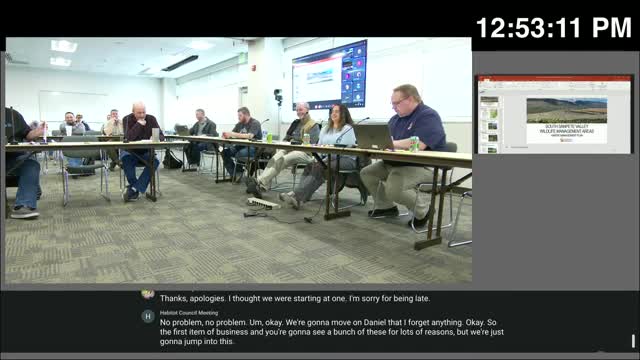Wildlife Management Area plan revised to enhance mule deer habitats and manage access
March 22, 2025 | Natural Resources Department, Utah Environment, State Agencies, Organizations, Utah Executive Branch, Utah
This article was created by AI summarizing key points discussed. AI makes mistakes, so for full details and context, please refer to the video of the full meeting. Please report any errors so we can fix them. Report an error »

In a recent meeting held by the Utah Department of Natural Resources, the focus was on the revised Habitat Management Plan for the South Sanpete Wildlife Management Area (WMA). Robbie Edgel, a habitat restoration biologist, presented the updates, emphasizing the importance of preserving the land for wildlife, particularly mule deer, while also benefiting a variety of other species.
The South Sanpete WMA encompasses ten properties, stretching from White Hill to Willow Creek, and is primarily aimed at maintaining the winter range for big game. Edgel highlighted the foresight of previous generations who secured these lands from development, allowing for a management plan that maximizes wildlife values. The plan includes habitat treatments, such as thinning juniper trees and restoring sagebrush, to enhance biodiversity.
Community involvement has been a cornerstone of the plan's development. Edgel noted that extensive public engagement took place during the initial plan's creation two decades ago and continued with multiple meetings for the current revisions. The updated plan aims to address the increasing popularity of mountain biking and the challenges posed by unauthorized trails, which have become a growing concern as urban areas expand.
One of the most significant changes in the revised plan is the new access management strategy. This plan seeks to balance responsible public access with the preservation of wildlife habitats. Edgel reported that discussions with various user groups, including mountain bikers and horseback riders, led to a compromise that maintains key trails while establishing winter closures to protect mule deer during critical periods.
The meeting also touched on the broader implications of these management strategies, with council members expressing the need for a firm stance against the proliferation of trails that could compromise the integrity of the WMAs. The discussions underscored the importance of collaboration among stakeholders to ensure that these areas remain dedicated to wildlife conservation.
As the meeting concluded, council members were encouraged to provide feedback on the plan within two weeks, marking a crucial step in the approval process. The Habitat Management Plan not only reflects a commitment to wildlife preservation but also highlights the ongoing dialogue between conservation efforts and recreational use, setting a precedent for future management practices in Utah's natural areas.
The South Sanpete WMA encompasses ten properties, stretching from White Hill to Willow Creek, and is primarily aimed at maintaining the winter range for big game. Edgel highlighted the foresight of previous generations who secured these lands from development, allowing for a management plan that maximizes wildlife values. The plan includes habitat treatments, such as thinning juniper trees and restoring sagebrush, to enhance biodiversity.
Community involvement has been a cornerstone of the plan's development. Edgel noted that extensive public engagement took place during the initial plan's creation two decades ago and continued with multiple meetings for the current revisions. The updated plan aims to address the increasing popularity of mountain biking and the challenges posed by unauthorized trails, which have become a growing concern as urban areas expand.
One of the most significant changes in the revised plan is the new access management strategy. This plan seeks to balance responsible public access with the preservation of wildlife habitats. Edgel reported that discussions with various user groups, including mountain bikers and horseback riders, led to a compromise that maintains key trails while establishing winter closures to protect mule deer during critical periods.
The meeting also touched on the broader implications of these management strategies, with council members expressing the need for a firm stance against the proliferation of trails that could compromise the integrity of the WMAs. The discussions underscored the importance of collaboration among stakeholders to ensure that these areas remain dedicated to wildlife conservation.
As the meeting concluded, council members were encouraged to provide feedback on the plan within two weeks, marking a crucial step in the approval process. The Habitat Management Plan not only reflects a commitment to wildlife preservation but also highlights the ongoing dialogue between conservation efforts and recreational use, setting a precedent for future management practices in Utah's natural areas.
View full meeting
This article is based on a recent meeting—watch the full video and explore the complete transcript for deeper insights into the discussion.
View full meeting

